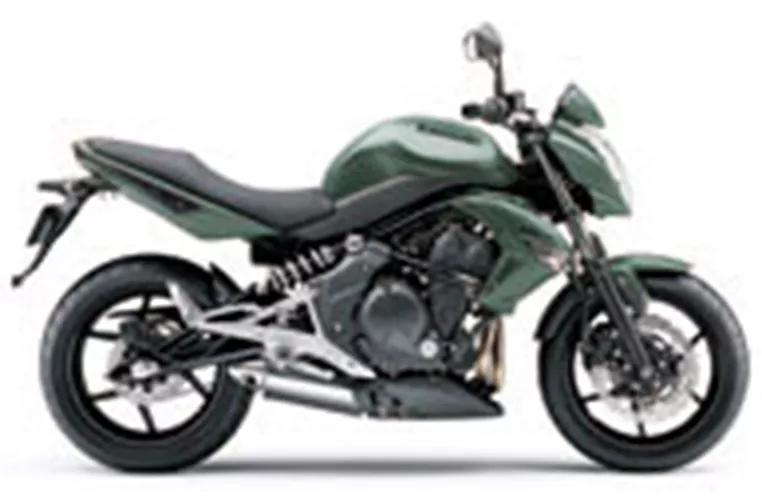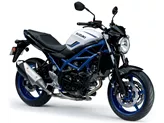Kawasaki ER-6n 2011 vs. Yamaha XSR700 2017

Kawasaki ER-6n 2011

Yamaha XSR700 2017
Visão geral - Kawasaki ER-6n 2011 vs Yamaha XSR700 2017
The Kawasaki ER-6n 2011 and the Yamaha XSR700 2017 are both naked bikes with similar technical specifications. They both have an inline engine with 2 cylinders and liquid cooling. The Kawasaki has a displacement of 649cc while the Yamaha has a slightly larger displacement of 689cc. In terms of power, the Yamaha has a slight advantage with 75 HP compared to the Kawasaki's 72 HP. The torque is also slightly higher on the Yamaha with 68 Nm compared to the Kawasaki's 66 Nm.
Both bikes have a monoshock rear suspension and a steel frame chassis. They also have double disc front brakes, but the Yamaha has four-piston calipers compared to the Kawasaki's dual-piston calipers. In terms of tire width, the Kawasaki has a 120mm front tire and a 160mm rear tire, while the Yamaha has a slightly wider 180mm rear tire. The wheelbase is slightly longer on the Kawasaki with 1410mm compared to the Yamaha's 1405mm. The seat height is also higher on the Yamaha with 815mm compared to the Kawasaki's 790mm.

Kawasaki ER-6n 2011
In terms of weight, the Yamaha is lighter with a curb weight of 186kg compared to the Kawasaki's 208kg. The fuel tank capacity is also slightly smaller on the Yamaha with 14 liters compared to the Kawasaki's 15.5 liters.
In terms of strengths, the Kawasaki ER-6n 2011 has ABS, a wider handlebar, a slimmer waist, a louder intake noise, a comfortable seat, and a simple chassis. On the other hand, the Yamaha XSR700 2017 has a wonderful engine, solid finish, cool retro look, a wide range of original accessories, excellent automatic gearbox, sporty and tight chassis, easy to ride, and brings joy to both kids and adults.

Yamaha XSR700 2017
As for weaknesses, the Kawasaki ER-6n 2011 doesn't have any listed weaknesses. However, the Yamaha XSR700 2017 has some weaknesses such as poor screen readability, the license plate holder being a matter of taste, lack of coherence in some design details, and weak wind protection when riding at high speeds.
Overall, both bikes have their strengths and weaknesses, and the choice between them would depend on personal preferences and priorities. The Kawasaki may be a better option for those who prioritize ABS and a comfortable seat, while the Yamaha may be more appealing for those who value a powerful engine and a retro look.
Especificações técnicas Kawasaki ER-6n 2011 em comparação com Yamaha XSR700 2017
Prós e contras em comparação
Prós e contras em comparação
Kawasaki ER-6n 2011

Não vai encontrar um pacote tão coerente com detalhes tão finos em qualquer outro lugar a este preço. O ER-6n voltou a ser um pouco mais nítido, tanto visual como dinamicamente, e é mais divertido do que nunca.
Yamaha XSR700 2017

A XSR é a moto perfeita para o dia a dia. Visualmente é uma festa para os olhos, tem uma quantidade incrível de potência, mas continua a ser leve e ágil. A posição do assento permite A posição do assento permite viagens mais longas, uma vez que a bagagem pode ser transportada nas costas sem qualquer problema. A própria XSR não sabe exatamente o que quer ser agora. Mas eu mas acho a mistura resultante bastante excitante. Por isso, se não quiser (ou não puder) ter motos diferentes na garagem, a XSR é uma óptima escolha. Servida muito bem. Tem tudo o que se espera de uma mota. Num hotel, falar-se-ia de uma oferta com tudo incluído. É perfeita para É perfeita para a deslocação diária para o escritório, para as excursões de fim de semana e para os passeios mais pequenos a sul. Mesmo com um passageiro, a moto é muito fácil de deslocar. Como de costume da Yamaha, a moto causa uma impressão muito sólida. Tudo simplesmente funciona aqui. O escapamento é agradavelmente silencioso, mas a partir de 5000 rpm produz um som muito atraente e gutural. A parte traseira é uma questão de gosto. Pessoalmente, eu reconstruiria a traseira e removeria os elementos plásticos. Também considero os espelhos retrovisores de série um pouco grandes. O visual retro não foi bem conseguido aqui. No entanto, isto pode ser alterado muito rapidamente e facilmente graças aos muitos acessórios. O painel de instrumentos é basicamente fácil de ler. No entanto, muita informação é espaço. Aqui, o design e a funcionalidade chocam um pouco. Resumido numa frase: A mota perfeita para todos os desafios.
Comparação de preços Preço médio de mercado Kawasaki ER-6n vs Yamaha XSR700
There are a few key differences between a Kawasaki ER-6n 2011 and a Yamaha XSR700 2017. In terms of price, the actual average price of a Yamaha XSR700 2017 is about 70% higher. A Kawasaki ER-6n 2011 experiences a loss of 1.560 BRL in one year and 3.370 BRL in two years of ownership. This is offset by a loss of 720 BRL and 5.260 BRL for a Yamaha XSR700 2017. Compared to Yamaha XSR700 2017 there are less Kawasaki ER-6n 2011 bikes available on the 1000PS.de Marketplace, specifically 5 compared to 7. It takes less time to sell a Kawasaki ER-6n with 49 days compared to 91 days for a Yamaha XSR700. Since model year 2006 1000PS.de editors have written 16 reviews for the Kawasaki ER-6n and 26 reviews for the Yamaha XSR700 since model year 2015. The first review for the Kawasaki ER-6n was published on 29/06/2005 and now has more than 11.200 views. This compares to more than 13.700 views for the first review on Yamaha XSR700 published on 22/07/2015.


















